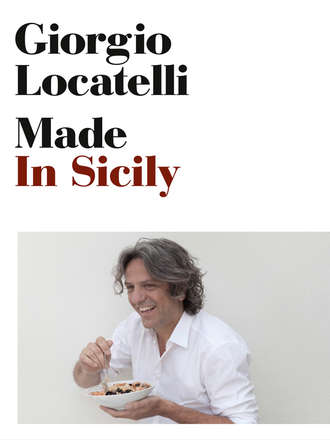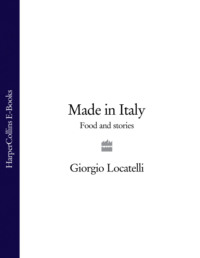
Полная версия
Made in Sicily
Sometimes it is called finocchietto di montagna, fennel of the mountains, but you don’t need to go near a mountain to see it. When I walk out of the house where we stay in Sicily near the sea, it is growing all along the path. So I might go into the village and buy a big fish, maybe a branzino (sea bass), or a gilt-head bream, then I will take some sliced potato, a couple of slices of lemon, put in some wild fennel, and maybe some mint, with the fish on top, add a little olive oil and bake it in the oven. When it cooks the fish takes on the fantastic aniseed flavour, which is more aromatic and grassy and less overpowering than the seeds can be: it just seems to produce a very fine note in the background to whatever you are cooking. It is a key ingredient in one of the island’s most famous dishes, pasta con le sarde (pasta with sardines, pasta con le sarde), it is put into the cooking water for broad beans, and picked fresh, it really helps the flavour of a tomato sauce and gives it another dimension, if you put it in at the last minute.
You can’t come back from Sicily without big bunches of wild fennel. It is impossible. The boys in the kitchen at Locanda would never forgive me. On the road towards the airport it grows all along the verges, so the last thing you do before you come home is get out of the car and pick some, and when you arrive to check in you see you are not the only one with the idea!
Panelle di fave
Broad bean fritters
These are similar to the panelle made with chickpea flour, but this time they are made with dried broad beans. Broad beans have a big significance in Sicily. The ancient Greeks believed the souls of the dead lived in fava beans, and they are still associated with All Souls’ Day on 2 November, when special biscuits are made in the shape of the beans. They are also meant to be a good omen, especially on Good Friday. When I was in Ragusa over the Easter holiday, we ate at a restaurant and we were each given three cooked (dried) beans, with a little salt and olive oil, to represent the Trinity, before the start of the meal.
The best are the beans of Leonforte, now supported by a Slow Food Presidium. When the young beans are harvested they are eaten fresh with spring onions and cheese, or added to frittedda and spring stews (Stufato di verdure primavera), but the dried beans are equally popular. They have a very different flavour to the fresh ones. You can buy them whole with the skins on, or already skinned and split, in Turkish and Jewish stores. If they are whole, once cooked put them through a sieve to lose the rough skins.
The beans are cooked with wild fennel (Finocchietto selvatico), but you could use a teaspoonful of fennel seeds, soaked for an hour or two in a tiny bit of water.
Serves 4
900g dried broad beans
½ medium onion, sliced
a few fronds of wild fennel, or 1 teaspoon of fennel seeds soaked in water
a pinch of dried chilli flakes (optional)
a little olive oil
vegetable oil for deep-frying
sea salt
Soak the dried beans in water overnight, then drain. The next morning put them into a pan with the onion and fennel, and the chilli flakes, if using. Add enough unsalted water to cover and bring to the boil. Turn down the heat and cook gently for 2–3 hours, adding a little water if necessary until the beans break down to form a very thick purée, then season to taste with salt. Keep stirring to avoid sticking, then pass through a sieve. Grease a work surface, preferably marble, with olive oil and pour the mixture on to it. Roll out to a thickness of about 5mm and allow to cool. Cut into 5cm strips.
Heat a few inches of vegetable oil in a pan, making sure it comes no higher than a third of the way up. It should be 180°C. If you don’t have a thermometer, put in a few breadcrumbs and if they sizzle the oil is ready. Deep-fry the strips until golden, about 1–2 minutes. Drain on kitchen paper and serve warm.


Maccheroni nel ‘maccu’ fritto
Pasta and fava (broad bean) cubes
This is another of those surprisingly delicious dishes born out of cucina povera. Maccu comes from the old Italian word maccare (to crush) and this is a simple purée of dried fava beans that you would make to eat on its own, with pasta or thinned down with water, to make a soup. If any purée was left over, you could leave it to harden, then cut it up and fry it the next day. In Palermo they traditionally mixed the purée with cooked squash, instead of fennel, and in the Madonie mountains, south-east of the city, they would add chopped tomato.
I also like the purée just served with onions, sautéed in olive oil, then mixed with a little salt, sugar and vinegar, on top, or some chicory, blanched quickly in boiling water, drained, then sautéed gently in olive oil with a little chopped garlic and chilli. The sweet and sour of the onions, or the bitterness of the chicory, make a great contrast with the maccu, which is quite sweet.
Serves 4
360g dried fava or broad beans
1 sprig of wild fennel or 1 teaspoon of fennel seeds, soaked in a little water
400g small macaroni
sea salt and freshly ground black pepper
extra virgin olive oil
4 tablespoons plain flour
vegetable oil for deep-frying
Soak the dried beans overnight. Next day, drain and put them into a pan with enough unsalted water to cover, bring to the boil, then turn down the heat, add the fennel and cook gently for 2–3 hours, stirring regularly to stop the beans from sticking, until they form a thick purée. Season with salt.
Cook the macaroni in plenty of boiling salted water for about 6 minutes, or until al dente. Drain and season generously with pepper. Mix with the broad bean purée. Grease a rectangular baking tray with extra virgin olive oil and spread the bean and macaroni mixture in a layer no more than 1.5cm thick. Put into the fridge overnight to solidify.
Next day, slice the maccu into small squares and dip them into the flour, shaking off any excess. Heat 2.5cm of vegetable oil in a deep pan, making sure it comes no higher than a third of the way up the pan. It should be 180°C. If you don’t have a thermometer, put in a few breadcrumbs and if they sizzle the oil is ready. Deep-fry the squares until golden on all sides. They can be eaten hot or cold.
Carciofi Artichokes
‘Black from the ashes, smoky, tender, delicious …’
The truly Sicilian way with artichokes is to bury them in the ash of a wood-burning stove after the bread has been made, or in the embers of the barbecue, and roast them slowly until they are black on the outside from the ashes, but smoky, tender and delicious inside.
In Sicily there is a big production of artichokes. It is not unusual for me to drop into Vittorio’s restaurant and find him and his wife, Francesca, or one of the women who helps him, working their way through five boxes of them, brought in that morning.
In spring and summer, if you buy artichokes from the local guys or in the stalls in the market, they come in bunches, some big, some small, usually with one or two baby artichokes attached. They are put into everything from frittedda and spring stews (Stufato di verdure primavera), made with fresh peas and broad beans, to caponata (Caponata), or they are simply blanched, then put under oil, perhaps with a little chilli, as an antipasto; or chopped and tossed in a salad with some olives and slices of lemon.
But my favourite way is this roasting in the ashes, usually of olive branches. There is even a special kind of graticola, an iron grill, enclosing a series of ‘cones’ for the purpose. Instead of peeling the tough outer leaves as you would normally do before cooking the artichokes, what you do is lay each artichoke on its side on a table and roll it, pressing down gently, to loosen the leaves; then you hold it by its stalk and press the tips down on the table, just enough to open out the leaves a little, so that the hot air can circulate through the artichokes as they cook.
Next you put them, stalk first, into the iron cones and push the grill into the ashes, leaving the tops of the artichokes showing, sprinkle them with salt and oil, and leave them for about forty minutes, so they boil from the inside, but char on the outside. Then you simply peel off the blackened leaves and eat them just as they are.
Конец ознакомительного фрагмента.
Текст предоставлен ООО «ЛитРес».
Прочитайте эту книгу целиком, купив полную легальную версию на ЛитРес.
Безопасно оплатить книгу можно банковской картой Visa, MasterCard, Maestro, со счета мобильного телефона, с платежного терминала, в салоне МТС или Связной, через PayPal, WebMoney, Яндекс.Деньги, QIWI Кошелек, бонусными картами или другим удобным Вам способом.





